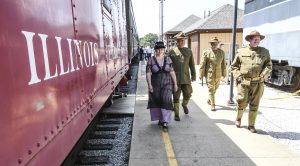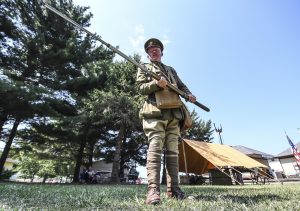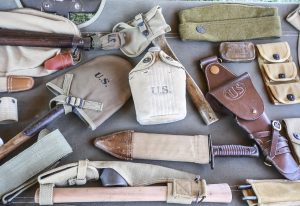BICENTENNIAL 2018: Illinois sent more than 350,000 soldiers to Europe during World War I
By Tony Reid Of the Herald & Review — November 8, 2018
Historians Andrea Miller, left, and others got a chance to ride the Monticello Railway Museum’s restored 1907 Southern 2-8-0 steam locomotive 401 on Aug. 19, 2017. The event was meant to symbolize the send-off of troops across the country as America entered World War I. “This kind of scene would have been going on all across the country, where wives would be saying goodbye to their husbands as they go off to war — some of them never to return,” said Bill Lear, curator at the Illinois State Military Museum in Springfield. (CLAY JACKSON, HERALD & REVIEW)
Artie Bennett, a Marine from Clinton, was cut down by a hail of bullets 100 years ago in a far-flung foreign field, giving his life for his country in America’s first global war.
A letter home from a fellow soldier said Bennett, 18, had been attacking a machine gun nest as the Marines fought, successfully, to stem a German advance threatening the French capital of Paris in June 1918, the last summer of World War I.
The fallen Marine had lingered for an hour before dying, one of the first casualties from Illinois. The letter honoring him, typed by fellow Marine Pvt. John W. Olsen, read: “He passed away quietly, without a complaint, and was laid to rest near where he fell.”
Immaculately tended American cemeteries in France, and faded memorials at home, are among the few tangible reminders of the “Great War” that began on July 28, 1914, and ended, after 18 million soldiers and civilians had died on all sides, with an armistice that went into effect at 11 a.m. on Nov. 11, 1918.
Now, nearing the 100th anniversary of the war’s end, the push is on to recall and honor the men and women of Illinois, and all across America, who suffered and sacrificed for their nation.
Congress has created a United States World War I Centennial Commission, which is overseeing commemorations and fundraising for a World War I memorial in Washington, D.C.
Illinois Gov. Bruce Rauner signed a proclamation announcing the Illinois National Guard and Chicago’s Pritzker Military Museum & Library will lead the effort to ensure the Land of Lincoln remembers its role in the Great War.
A World War I Centennial Committee has been drafted to aid in that state mission and it’s chaired by Jeanne Hamacher, who has taught high school history classes. She said the key lesson to learn is that Illinois went to extraordinary efforts to support a war that shaped the world we live in, right up through today.
“When I was teaching, I did a lesson where I could link basically every conflict the United States has had (since World War I) back to World War I in some shape or form,” Hamacher said. She said Illinois had helped win the war, and the war changed the world forever.
“Schools need to teach this, we need to remember,” she added.

Great War Living History Enthusiast Ian Houghton talks about Britain’s involvement in World War I during the World War I Encampment at Monticello Railway Museum on Aug. 19, 2017. The event, sponsored by the Monticello Railway Museum and the Illinois State Military Museum, signified the departure of Illinois Army National Guard troops to Camp Logan, Texas, for mobilization training from September to October 1917. (CLAY JACKSON, HERALD & REVIEW)
The United States declared war on Germany and its Central Powers allies on April 6, 1917, and Illinois became part of the vast conflict that would mark America’s emergence as a global superpower.
The United States sent 4,734,991 soldiers and sailors to Europe and suffered 116,516 deaths, according to the U.S. Department of Veterans Affairs.
Records from the Illinois Office of the Adjutant General list more than 351,000 Illinois men who served in the Army, Navy and Marines during World War I, and some 5,000 of them died.
One of every 12 enlistees in the Army hailed from Illinois, and each left a mark.
The American Legion Post in Clinton is Crang-Bennett Post 103, named for the fallen Marine and also Army Sgt. 1st Class Welby Crang, who lived about a block from Bennett and died in France in 1917 from pneumonia.
Ron Devore, 86, is a member of the Post 103 executive board and a former post commander who has fought to keep the memory of the World War I soldiers alive. He said the post was founded in 1919 not just to honor fallen veterans, but to help and lobby for those who returned home alive, if not always in one piece.
“Some of these guys had been gassed, their lungs were burned, they had missing limbs and disabilities; they were messed up for life, and they weren’t getting anything from the government,” Devore said. “Veterans knew that, if there was a bunch of them banded together, they could have a voice in Washington, D.C.”
Devore’s wife, Marjorie, whose father was a World War I veteran, vividly recalls the returned soldiers’ sense of pride despite all their trials and tribulations. She said that pride had been matched by the patriotic fervor of their communities at home. “My dad always said everybody had supported the war effort,” she said.
The civilian push to buoy the troops with maximum support on the home front was extraordinary. Illinois mobilized vast forces of industry, and especially industrialized agriculture, and turned them into an arsenal of democracy that flooded the American war effort with food, war material and cash
Illinois created the State Council of Defense, the job of which was to persuade, corral and control civilian production, from engineering to seed corn, to fuel the war machine. When the council produced its wrap-up report in 1919, it was suffused with pride at the sheer wartime output from the people of Illinois.
It pointed out that the state’s agricultural production for 1918 had been geared to meet the needs of the wartime “national food authorities” and had been the third-largest crop harvest in state history, worth close to $880 million (about $15 billion in today’s dollars).
“Notwithstanding the drain upon manpower, the state in 1918 turned out manufactured products valued at $6 billion. … Of these, $2 billion-worth were on direct war contracts, but virtually all were war contributions, for Illinois factories are not largely given to the production of luxuries or non-essentials,” the council reported.
It also lauded the generosity of Illinois citizens, who raised $45 million during the war to support everything from the Red Cross to the YMCA and the Salvation Army.
Timothy Kovalcik, associate professor of history at Millikin University, said it’s important to understand the wartime atmosphere gripping Illinois and the entire nation.
“Support for the war was at fever pitch and the propaganda was incredibly successful,” Kovalcik said.

Several items from a private World War I collection were displayed at the Monticello Railway Museum during the August 2017 encampment. (CLAY JACKSON, HERALD & REVIEW)
A state with a significant population of Germanic ancestry (Teutopolis in Effingham County, for example, means “City of the Teutons,” or Germans, and is typical of many towns founded by German settlers) had no trouble raising troops.
“The population of German ancestry volunteered at massive rates to show their patriotism,” Kovalcik said. “They wanted to prove they were true Americans.”
With troops rushing forward and humming factories full of nose-to-grindstone workers who had shunted aside labor grumbles for the greater patriotic good, the State Council of Defense believed it had glimpsed capitalism’s promised land.
“All war undertakings succeeded by virtue of the spirit of cooperation,” it concluded in its final 1919 report. “Since this unity of thought and purpose can be achieved under stress of war, why can it not be approximated, at least, in time of peace?”
But it was not to be. Kovalcik said a big influence that had pushed President Woodrow Wilson to steer America into the war is that much of it on the British side had been financed by American banks. They stood to lose their shirts big time if Britain and its Allies, fatigued with crippling losses by 1917, were defeated. And yet when the American intervention was over and the war won, the demand that had quadrupled the U.S. economy between 1914 and 1917 suddenly collapsed, taking jobs with it.
By the dawn of the Great Depression in the 1930s, jobless and hungry World War I veterans and their families, some 17,000 of them, had marched on Washington, D.C. They were demanding early payment of war service bonuses promised by Congress but not due to be distributed until 1945. On July 28, President Herbert Hoover ordered in the Army to help the police clear the protesters and, in street battles that followed, two veterans were killed.
Finally, in 1936, Congress overrode the veto of President Franklin D. Roosevelt and the veterans were paid their bonuses nine years early.
Editor’s note: The weekly Illinois Bicentennial series is brought to you by the Illinois Associated Press Media Editors and Illinois Press Association. More than 20 newspapers are creating stories about the state’s history, places and key moments in advance of the Bicentennial on Dec. 3, 2018. Stories published up to this date can be found at 200illinois.com.
–BICENTENNIAL 2018: Illinois sent more than 350,000 soldiers to Europe during World War I–







